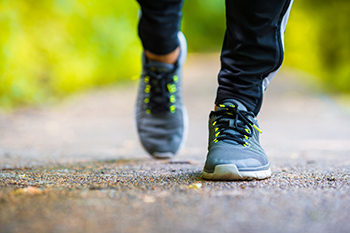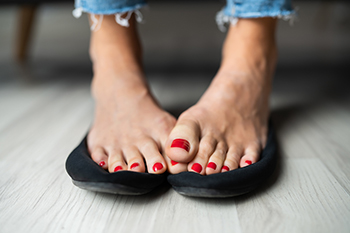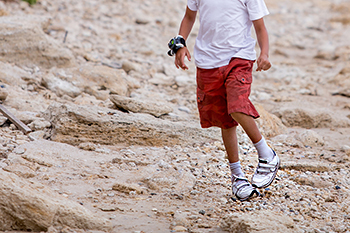
Flat shoes are all too common among the general public. For example, canvas shoes and flip-flops are flat shoes that have next to no cushioning or support. Yet despite this, they can be exceedingly popular among many people. However, consistently wearing flat shoes can cause the feet a considerable amount of pain. As a general rule, someone who cares about the health of their feet should minimize the extent to which they are wearing shoes with no arch support. Additionally, shoes that have extremely thin soles are generally not a wise decision to make if you are struggling with foot pain of any kind. If you currently have foot pain or are wearing flat shoes, contact a podiatrist today to schedule an appointment. This foot specialist will be able to help you address any problems you are having. A podiatrist can answer your questions or treat any foot conditions you may have.
Foot Pain
Foot pain can be extremely painful and debilitating. If you have a foot pain, consult with Dr. Richard DiMario from Maine. Our doctor will assess your condition and provide you with quality foot and ankle treatment.
Causes
Foot pain is a very broad condition that could be caused by one or more ailments. The most common include:
Diagnosis
To figure out the cause of foot pain, podiatrists utilize several different methods. This can range from simple visual inspections and sensation tests to X-rays and MRI scans. Prior medical history, family medical history, and any recent physical traumatic events will all be taken into consideration for a proper diagnosis.
Treatment
Treatment depends upon the cause of the foot pain. Whether it is resting, staying off the foot, or having surgery; podiatrists have a number of treatment options available for foot pain.
If you have any questions, please feel free to contact our office located in York, ME . We offer the newest diagnostic and treatment technologies for all your foot care needs.

Athlete’s foot is a fairly well-known foot condition that occurs when a fungal infection is spread, often in warm and moist environments. As a result, the athlete’s foot rash can develop on the feet, especially in between the toes. The athlete’s foot rash is distinctive for many different reasons. First, the rash will usually be discolored with a red color. Additionally, the rash will also appear to be somewhat moist in texture. The rash may also be accompanied by a series of small blisters that can spread across the feet. The infection from athlete’s feet may also even extend beyond the toes on the feet, reaching the soles of the feet and the toenails. If you are someone that is interested in learning more about athlete’s foot or believe that you may have the condition yourself, contact a podiatrist today for more information.
Athlete’s foot is an inconvenient condition that can be easily reduced with the proper treatment. If you have any concerns about your feet and ankles, contact Dr. Richard DiMario from Maine. Our doctor will treat your foot and ankle needs.
Athlete’s Foot: The Sole Story
Athlete's foot, also known as tinea pedis, can be an extremely contagious foot infection. It is commonly contracted in public changing areas and bathrooms, dormitory style living quarters, around locker rooms and public swimming pools, or anywhere your feet often come into contact with other people.
Solutions to Combat Athlete’s Foot
Athlete’s foot can cause many irritating symptoms such as dry and flaking skin, itching, and redness. Some more severe symptoms can include bleeding and cracked skin, intense itching and burning, and even pain when walking. In the worst cases, Athlete’s foot can cause blistering as well. Speak to your podiatrist for a better understanding of the different causes of Athlete’s foot, as well as help in determining which treatment options are best for you.
If you have any questions please feel free to contact our office located in York, ME . We offer the newest diagnostic and treatment technologies for all your foot and ankle needs.

A well-fitting shoe is the most important consideration when selecting shoes for an aging foot. Seniors should be particularly mindful of having their feet measured when they buy shoes as the foot changes as aging occurs. The arch can fall, and the foot can become longer and wider. Issues with the forefoot are common in seniors and properly fit shoes, with sufficient room in the toe box, will help in preventing pain in this area as well as problems with toenails and bunions. Shoe quality varies by brand and just because a shoe fits in one size with one brand or model does not mean it will when considering another brand or model. Visiting a podiatrist is helpful in understanding the right shoes for your feet as you age.
Proper foot care is something many older adults forget to consider. If you have any concerns about your feet and ankles, contact Dr. Richard DiMario from Maine. Our doctor can provide the care you need to keep you pain-free and on your feet.
The Elderly and Their Feet
As we age we start to notice many changes in our body, but the elder population may not notice them right away. Medical conditions may prevent the elderly to take notice of their foot health right away. Poor vision is a lead contributor to not taking action for the elderly.
Common Conditions
Susceptible Infections
Diabetes and poor circulation can cause general loss of sensitivity over the years, turning a simple cut into a serious issue.
If you have any questions please feel free to contact our office located in York, ME . We offer the newest diagnostic and treatment technologies for all your foot and ankle needs.

Sweaty feet can be a temporary problem caused by having your feet enclosed in shoes and socks all day, or from high temperatures. But if having sweaty feet is an everyday occurrence, the chances are that you have a condition known as hyperhidrosis. This condition is thought to be genetic in nature. Some people are born with overactive sweat glands, and the moisture produced goes well beyond sweating from hot weather, exercising, or stress. Several underlying health conditions and certain foods may also cause hyperhidrosis. In some cases of hyperhidrosis, bacteria forms around the feet, causing them to emit a foul odor. It is a good idea to use antibacterial soap regularly to keep the feet clean and healthy. Wearing moisture-wicking socks or open-toed shoes or sandals is a good way to keep your feet dry. A podiatrist can offer more advanced treatment options, including several prescribed antiperspirant medications. In extreme cases, surgery to block the nerve passageway that tells the feet to sweat can be performed. For more information, please contact a podiatrist.
If you are suffering from hyperhidrosis contact Dr. Richard DiMario of Maine. Our doctor can provide the care you need to attend to all of your foot and ankle needs.
Hyperhidrosis of the Feet
Hyperhidrosis is a rare disorder that can cause people to have excessive sweating of their feet. This can usually occur all on its own without rigorous activity involved. People who suffer from hyperhidrosis may also experience sweaty palms.
Although it is said that sweating is a healthy process meant to cool down the body temperature and to maintain a proper internal temperature, hyperhidrosis may prove to be a huge hindrance on a person’s everyday life.
Plantar hyperhidrosis is considered to be the main form of hyperhidrosis. Secondary hyperhidrosis can refer to sweating that occurs in areas other than the feet or hands and armpits. Often this may be a sign of it being related to another medical condition such as menopause, hyperthyroidism and even Parkinson’s disease.
In order to alleviate this condition, it is important to see your doctor so that they may prescribe the necessary medications so that you can begin to live a normal life again. If this is left untreated, it is said that it will persist throughout an individual’s life.
A last resort approach would be surgery, but it is best to speak with your doctor to find out what may be the best treatment for you.
If you have any questions please feel free to contact our office located in York, ME . We offer the newest diagnostic and treatment technologies for all your foot and ankle needs.

Corns can develop as a way to respond to pressure inflicted on the feet. For example, when pressure is applied to the feet, corns may develop. Corns are similar to calluses in that they are made up of layers of hardened skin. Many different people can develop corns. In fact, just about anyone can be susceptible to experiencing them, with the exception of babies who have not yet begun walking. Certain people can be at an increased risk of developing corns. These individuals include people who wear ill-fitting shoes. This is because ill-fitting shoes can be a source of pressure to the feet, causing friction and ultimately corns. Another group of individuals that are particularly susceptible to corns are those who frequently walk or run. If you find yourself falling into any of these categories, consider consulting a podiatrist today for more information.
If you have any concerns regarding your feet and ankles, contact Dr. Richard DiMario of Maine. Our doctor will treat your foot and ankle needs.
Corns: What Are They? and How Do You Get Rid of Them?
Corns can be described as areas of the skin that have thickened to the point of becoming painful or irritating. They are often layers and layers of the skin that have become dry and rough, and are normally smaller than calluses.
Ways to Prevent Corns
There are many ways to get rid of painful corns such as wearing:
Treating Corns
Treatment of corns involves removing the dead skin that has built up in the specific area of the foot. Consult with Our doctor to determine the best treatment option for your case of corns.
If you have any questions please feel free to contact our office located in York, ME . We offer the newest diagnostic and treatment technologies for all your foot and ankle needs.

The medical term for the foot condition that is referred to as clubfoot is congenital talipes equinovarus. The abbreviation for this is CTEV, and the noticeable symptom seen is the feet turned inward at the ankle. There are two categories of clubfoot, postural and structural. A postural CTEV consists of muscle imbalance without involving the joints and bones. A child who has clubfoot that does not have full range of motion in their feet is afflicted with structural CTEV. The majority of babies who have this congenital foot disorder may not have complications until walking begins. At that point, a walking disorder will be evident, and there may be foot pain. Many parents are aware their child may have clubfoot during the pregnancy, when an ultrasound is taken. Steps can be taken soon after birth to correct this condition. If your child has clubfoot, it is strongly suggested that he or she is under the care of a podiatrist who can help you to determine the correct steps for recovery.
Congenital foot problems require immediate attention to avoid future complications. If you have any concerns, contact Dr. Richard DiMario of Maine. Our doctor can provide the care you need to keep you pain-free and on your feet.
Congenital foot problems are deformities affecting the feet, toes, and/or ankles that children are born with. Some of these conditions have a genetic cause while others just happen. Some specific foot ailments that children may be born with include clubfeet, polydactyly/macrodactyly, and cleft foot. There are several other foot anomalies that can occur congenitally. What all of these conditions have in common is that a child may experience difficulty walking or performing everyday activities, as well as trouble finding footwear that fits their foot deformity. Some of these conditions are more serious than others. Consulting with a podiatrist as early as possible will help in properly diagnosing a child’s foot condition while getting the necessary treatment underway.
What are Causes of Congenital Foot Problem?
A congenital foot problem is one that happens to a child at birth. These conditions can be caused by a genetic predisposition, developmental or positional abnormalities during gestation, or with no known cause.
What are Symptoms of Congenital Foot Problems?
Symptoms vary by the congenital condition. Symptoms may consist of the following:
Treatment and Prevention
While there is nothing one can do to prevent congenital foot problems, raising awareness and receiving neonatal screenings are important. Early detection by taking your child to a podiatrist leads to the best outcome possible.
If you have any questions please feel free to contact our office located in York, ME . We offer the newest diagnostic tools and technology to treat your foot and ankle needs.

The importance of practicing everyday foot care is crucial for people who have diabetes. This can begin by washing and drying the feet thoroughly, followed by inspecting the bottom of the feet by using a mirror. If a family member or caregiver is available, they can also help with this. Neuropathy is a common condition for diabetic patients to develop and this is a nerve disorder that causes the inability to feel existing cuts or scrapes on the feet. If these cuts do not receive the prompt medical attention they need, they can become infected and ultimately lead to a diabetic foot ulcer. It is beneficial to properly trim the toenails weekly as this may help to prevent a painful ingrown toenail from developing. Additionally, it is suggested that diabetic patients always wear shoes and socks as well as frequently elevate the legs to help increase circulation. Diabetic patients are urged to be under the care of a podiatrist who can treat and manage this condition.
Diabetic foot care is important in preventing foot ailments such as ulcers. If you are suffering from diabetes or have any other concerns about your feet, contact Dr. Richard DiMario from Maine. Our doctor can provide the care you need to keep you pain-free and on your feet.
Diabetic Foot Care
Diabetes affects millions of people every year. The condition can damage blood vessels in many parts of the body, especially the feet. Because of this, taking care of your feet is essential if you have diabetes, and having a podiatrist help monitor your foot health is highly recommended.
The Importance of Caring for Your Feet
Patients with diabetes should have their doctor monitor their blood levels, as blood sugar levels play such a huge role in diabetic care. Monitoring these levels on a regular basis is highly advised.
It is always best to inform your healthcare professional of any concerns you may have regarding your feet, especially for diabetic patients. Early treatment and routine foot examinations are keys to maintaining proper health, especially because severe complications can arise if proper treatment is not applied.
If you have any questions please feel free to contact our office located in York, ME . We offer the newest diagnostic and treatment technologies for all your foot and ankle needs.

New parents ought to be aware of signs of poor circulation in infants, as this condition can negatively impact the health of your infant. Importantly, poor circulation might be normal for a few hours following birth, however, persistent poor circulation can require medical attention. The feet can play an important role in helping you identify poor circulation in an infant. For example, if the feet feel cold to the touch, this might be indicative of a lack of sufficient blood circulation. The hands might feel cold as well. Often, the feet can give us important signals that we should not ignore. If you are a new parent or are expecting to be, see a podiatrist today to learn about the many ways in which you can care for your infant’s feet. This foot specialist will be able to help you develop a plan and teach you what signs to look for.
Poor circulation is a serious condition and needs immediate medical attention. If you have any concerns with poor circulation in your feet contact Dr. Richard DiMario of Maine. Our doctor will treat your foot and ankle needs.
Poor Circulation in the Feet
Poor blood circulation in the feet and legs is can be caused by peripheral artery disease (PAD), which is the result of a buildup of plaque in the arteries.
Plaque buildup or atherosclerosis results from excess calcium and cholesterol in the bloodstream. This can restrict the amount of blood which can flow through the arteries. Poor blood circulation in the feet and legs are sometimes caused by inflammation in the blood vessels, known as vasculitis.
Causes
Lack of oxygen and oxygen from poor blood circulation restricts muscle growth and development. It can also cause:
Those who have diabetes or smoke are at greatest risk for poor circulation, as are those who are over 50. If you have poor circulation in the feet and legs it may be caused by PAD and is important to make changes to your lifestyle in order to reduce risk of getting a heart attack or stroke. Exercise and maintaining a healthy lifestyle will dramatically improve conditions.
As always, see a podiatrist as he or she will assist in finding a regimen that suits you. A podiatrist can also prescribe you any needed medication.
If you have any questions please feel free to contact our office located in York, ME . We offer the newest diagnostic and treatment technologies for all your foot and ankle needs.